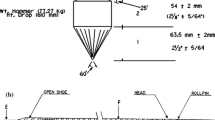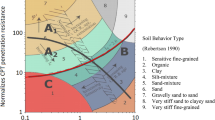Abstract
This study analyzes blowcount data from instrumented Texas Cone Penetration (TCP) tests. TCP hammer efficiency, rod length influence on the hammer efficiency, and overburden pressure correction factors for the TCP blowcounts (NTCP) are explored. Results are compared to published correction factors for the standard penetration test (SPT). The final dataset analyzed for this study consisted of 293 TCP tests from which 135 tests were instrumented. TCP hammer efficiency values for automatic trip hammers ranged from 74 to 101% with an average of 89%. Analyses showed a statistically-significant relationship between the TCP hammer efficiency and the rod length below ground surface. Statistical models were developed for undifferentiated soils, and corresponding rod length correction factors for the TCP test (CR-TCP) were obtained ranging from 0.90 to 1.00. In a second analysis, the relationship between the overburden pressure and NTCP was explored and a mathematical expression for the overburden correction factor for the TCP blowcount value (CN-TCP) was determined. This work represents the first study where corrections to NTCP are explored, and the outcome of this research benefits the geotechnical engineering community using the TCP test and its associated foundation design method.








Similar content being viewed by others
Notes
AWJ refers to conventional taper threaded drill rod—outside diameter 44.5 mm, thread pitch 5.1 mm.
NWJ refers to conventional taper threaded drill rod—outside diameter 66.7 mm, thread pitch 6.4 mm.
Abbreviations
- a and b:
-
Skempton (1986) soil dependent parameters
- Cb :
-
Borehole diameter correction factor for SPT
- CI:
-
Confidence intervals
- CN :
-
Overburden correction factor for SPT
- CN-TCP :
-
Overburden correction factor for TCP
- COV:
-
Coefficient of variation
- Cr :
-
Rod length correction factor for SPT
- CR-TCP :
-
Rod length correction factor for TCP
- Cs :
-
Sampler type correction factor for SPT
- DR :
-
Relative density
- Em :
-
Measured hammer energy
- Er :
-
Hammer efficiency-SPT
- Er-TCP :
-
Hammer efficiency-TCP
- Et :
-
Theoretical hammer energy
- K:
-
Exponent of the power function developed for overburden correction factor
- N1-60 :
-
SPT blowcount standardized to 60% energy and corrected for overburden
- N1-60-TCP :
-
TCP blowcount standardized to 60% energy and corrected for overburden
- N60 :
-
SPT blowcount standardized to 60% energy
- N60-TCP :
-
TCP blowcount standardized to 60% energy
- NN-TCP :
-
Normalized TCP blowcount to a blowcount corresponding to a reference stress
- NSPT :
-
SPT blowcount
- NTCP :
-
TCP blowcount
- PI:
-
Prediction intervals
- SPT:
-
Standard penetration test
- TCP:
-
Texas Cone Penetrometer
- z :
-
Depth
- z 1 :
-
Depth of interest
- z Baseline :
-
Depth at which the fitted model has flattened
- β1 :
-
Slope for a linear model equation
- βo :
-
Intercept for a linear model equation
- \(\upsigma_{\text{v}}^{\prime }\) :
-
Effective vertical stress
- \(\upsigma_{\text{ref}}^{\prime }\) :
-
Reference stress (i.e. 100 kPa, 2000 psf)
- \(\upsigma_{\text{N}}^{\prime }\) :
-
Normalized effective vertical stress to a reference stress
References
Aggour MS, Radding WR (2001) Standard penetration test (SPT) correction, Report No. MD02-007B48, Maryland State Highway Administration, Baltimore
ASTM International (2016) Standard test method for standard penetration test (SPT) and split-barrel sampling of soils, test method D1586-11. ASTM International, West Conshohocken, PA
Boulanger RW, Idriss IM (2012) Probabilistic standard penetration test-based liquefaction-triggering procedure. J Geotech Geoenviron Eng 138(10):1185–1195
Boulanger RW, Idriss IM (2015) CPT-based liquefaction triggering procedure. J Geotech Geoenviron Eng 10:1061
Bowles JE (1996) Foundation analysis and design, 5th edn. McGraw-Hill, New York
Brown RE (1977) Drill rod influence on standard penetration test. J Geotech Eng Div 103(11):1332–1336
Clayton CR (1995) The standard penetration test (SPT): methods and use (No. R 143). Construction Industry Research and Information Association
Coduto DP, Yeung MCR, Kitch WA (2011) Geotechnical engineering: principles and practices, 2nd edn. Prentice Hall, New Jersey
Daniel CR, Howie JA, Campanella RG, Sy A (2004) Characterization of SPT grain size effects in gravels. In: Second international conference on site characterization (ISC’2)
Das BM, Sobhan K (2014) Principles of geotechnical engineering, 8th edn. Cengage Learning, Connecticut
DeMello VF (1971, June) The standard penetration test. In: Proceedings of the 4th Pan-American conference on soil mechanics and foundation engineering, San Juan, PR,vol 1, pp 1–86
FHWA (2016) National bridge inventory. bridges and structures, safety, bridge inspection. U.S. Department of Transportation, Federal Highway Administration, Washington, DC
Fletcher GF (1965) Standard penetration test its uses and abuses. J Soil Mech Found SM4, Paper 4395
Honeycutt JN, Kiser SE, Anderson JB (2014) Database evaluation of energy transfer for central mine equipment automatic hammer standard penetration tests. ASCE J Geotech Geoenviron Eng 140(1):194–200
Idriss IM, Boulanger RW (2012) Examination of SPT-based liquefaction triggering correlations. Earthq Spectra 28(3):989–1018
Ireland HO, Moretto O, Vargas M (1970) The dynamic penetration test: A standard that is not standardized. Geotechnique 20(2):185–192
Kovacs WD, Salomone LA (1982) SPT hammer energy measurement. J Geotech Eng 110(4):562–564
Liao SS, Whitman RV (1986) Overburden correction factors for SPT in sand. Journal of Geotech Eng 112(3):373–377
Loehr JE, Bowders JJ, Ge L, Likos WJ, Luna R, Maerz N, Rosenblad BL, Stephenson RW (2011) Engineering policy guidelines for design of drilled shafts. Missouri Department of Transportation, Final Report for Project TRyy0922, Report cmr12003
Meyerhof GG (1957) Discussion on research on determining the density of sands. In: Proceedings of 4th international conference of soil mechanics and foundation engineering
Moghaddam RB (2016) Evaluation of the TxDOT texas cone penetration test and foundation design method including correction factors, allowable total capacity, and resistance factors at serviceability limit state. Doctoral dissertation, Texas Tech University
Nam MS, Park YH, Park YS (2013) Prediction of end bearing capacity for pre-bored steel pipe piles using instrumented SPT rods. J Korean Geotech Soc 29(12):105–111
Odebrecht E, Schnaid F, Rocha MM, de Paula Bernardes G (2005) Energy efficiency for standard penetration tests. J Geotech Geoenviron Eng 131(10):1252–1263
Palmer DJ, Stuart JG (1957) Some observations on the standard penetration test and a correlation of the test with a new penetrometer. In: Proceedings of 4th international conference on soil mechanics and foundation engineering, p 231
Peck RB, Hanson WE, Thornburn TH (1974) Foundation engineering, vol 10. Wiley, New York
Robertson PK, Sully JP, Woeller DJ, Lunne T, Powell JJM, Gillespie DG (2000) Estimating coefficient of consolidation from piezocone tests. Can Geotech J 29(4):539–550
Schmertmann JH, Palacios A (1979) Energy dynamics of SPT. J Geotech Eng Div 105(8):909–926
Schnaid F (2009) In situ Testing in Geomechanics: the main tests, 1st edn. Taylor & Francis, London and New York
Seed HB, Tokimatsu K, Harder L, Chung RM (1984) The influence of SPT procedures in evaluating soil liquefaction resistance. Report, University of California Berkley, Earthquake Engineering Research Center, 84–15
Seo H, Moghaddam RB, Surles JG, Jayawickrama PW, Wood TA, Lawson WD (2015) Reliability based deep foundation design using texas cone penetrometer (TCP) test: volume 1, development of load test dataset. DRAFT Report. FHWA/TX-14-0-6788-1-Vol. 1. Texas Tech University Center for Multidisciplinary Research in Transportation, Lubbock, TX
Skempton AW (1986) Standard penetration test procedures and the effects in sands of overburden pressure, relative density, particle size, ageing and over-consolidation. Geotechnique 36(3):425–447
Standard Guide to Standard Penetration Test Analyzer (2013) Pile Dynamics Inc
Texas Highway Department (1956) Foundation exploration and design manual, Bridge Division, Texas Highway Department
Texas Department of Transportation (1999) Geotechnical manual
Texas Department of Transportation (2000) Geotechnical manual
Texas Department of Transportation (2012) Geotechnical manual. Texas Department of Transportation
Tokimatsu K, Yoshimi Y (1983) Empirical correlation of soil liquefaction based on SPT N-value and fines content. Soils Foundations 23(4):56–74
Touma FT, Reese LC (1972) The behavior of axially loaded drilled shafts in sand, Report No. CFHR 3-5-72-176-1 University of Texas Center for Highway Research
Turner J (2006) Rock-socketed shafts for highway structure foundations. NCHRP synthesis 360. A synthesis of highway practice. Transportation Research Board, Washington, DC
Vipulanandan C(2007) Recent advances in designing, monitoring, modeling and testing deep foundations in North America. In: Kikuchi Y, Otani J, Kimura M, Morikawa Y (eds) Advances in deep foundations: proceedings of the international workshop on recent advances of deep foundations (IWDPF07), Port and Airport Research Institute, Yokosuka, Japan, 1–2 February, 2007. Taylor and Francis Group, London
Acknowledgements
The authors express their gratitude to the Texas Department of Transportation for sponsoring the TCP Reliability research study. The authors also thank Terracon, PSI, Rick Coffman (University of Arkansas), The Arkansas State Highway and Transportation Department, the Missouri Department of Transportation, the Louisiana Department of Transportation and Development, and the New Mexico Department of Transportation for their collaboration throughout the TCP Reliability research project.
Author information
Authors and Affiliations
Corresponding author
Rights and permissions
About this article
Cite this article
Moghaddam, R.B., Lawson, W.D., Surles, J.G. et al. Hammer Efficiency and Correction Factors for the TxDOT Texas Cone Penetration Test. Geotech Geol Eng 35, 2147–2162 (2017). https://doi.org/10.1007/s10706-017-0234-8
Received:
Accepted:
Published:
Issue Date:
DOI: https://doi.org/10.1007/s10706-017-0234-8




